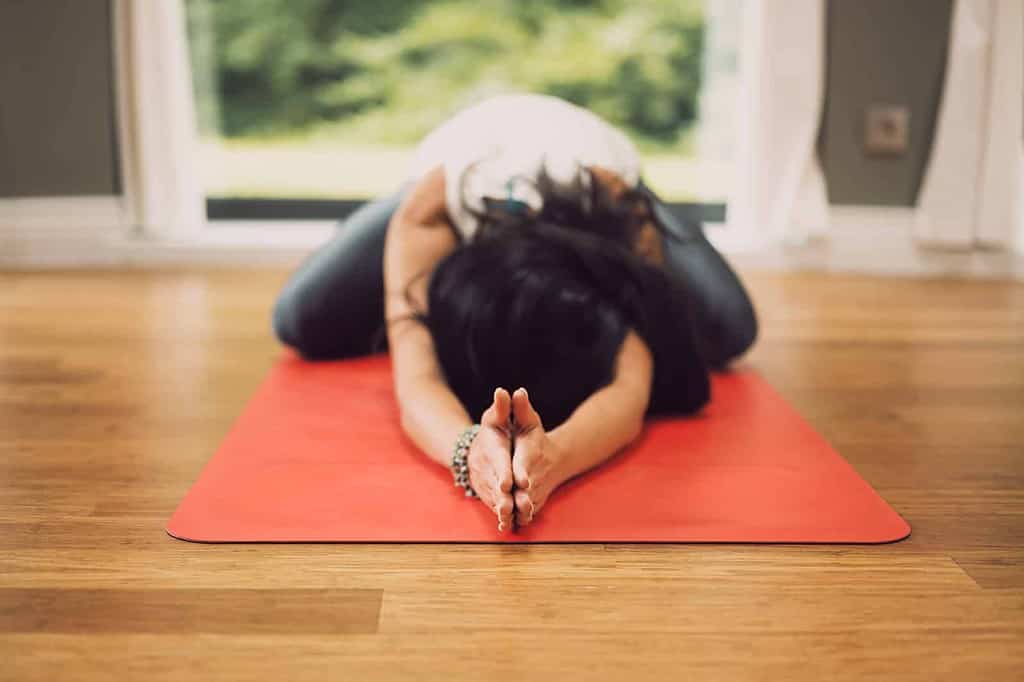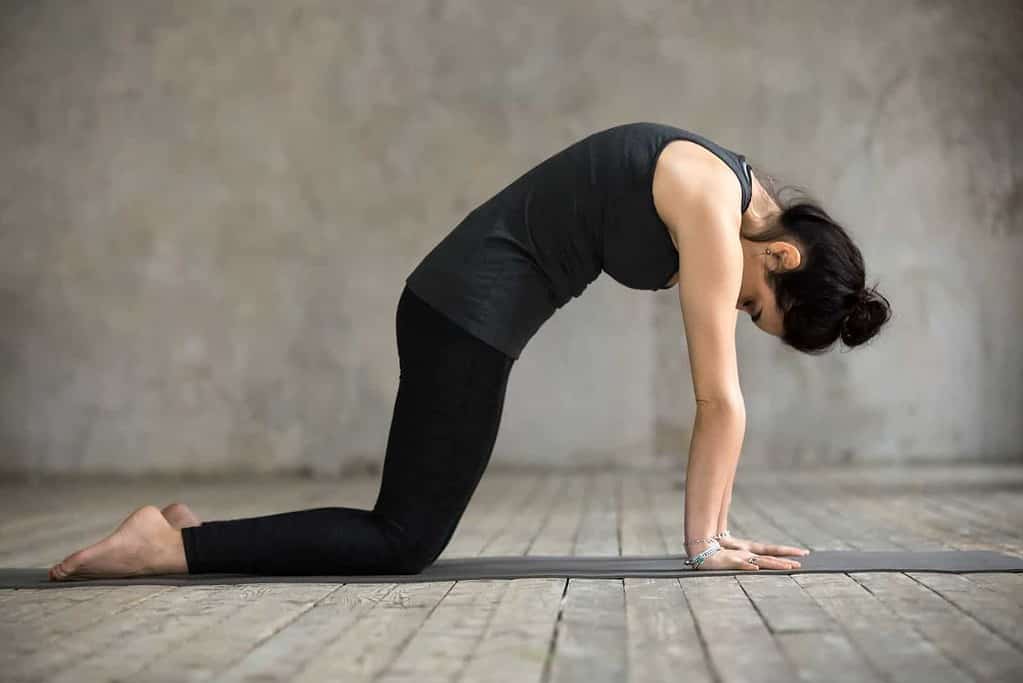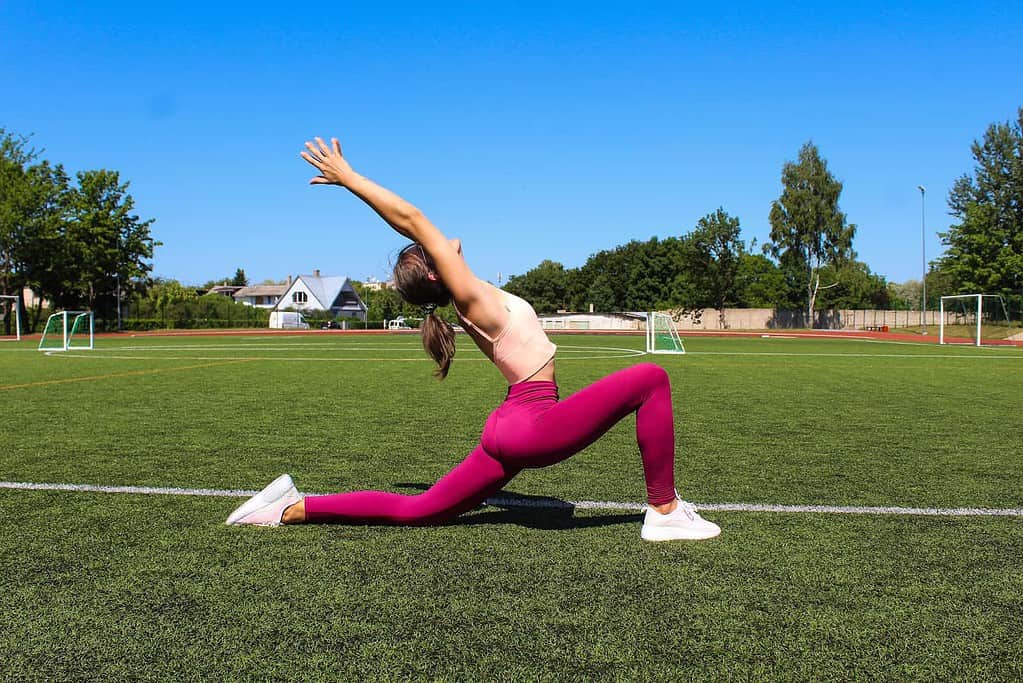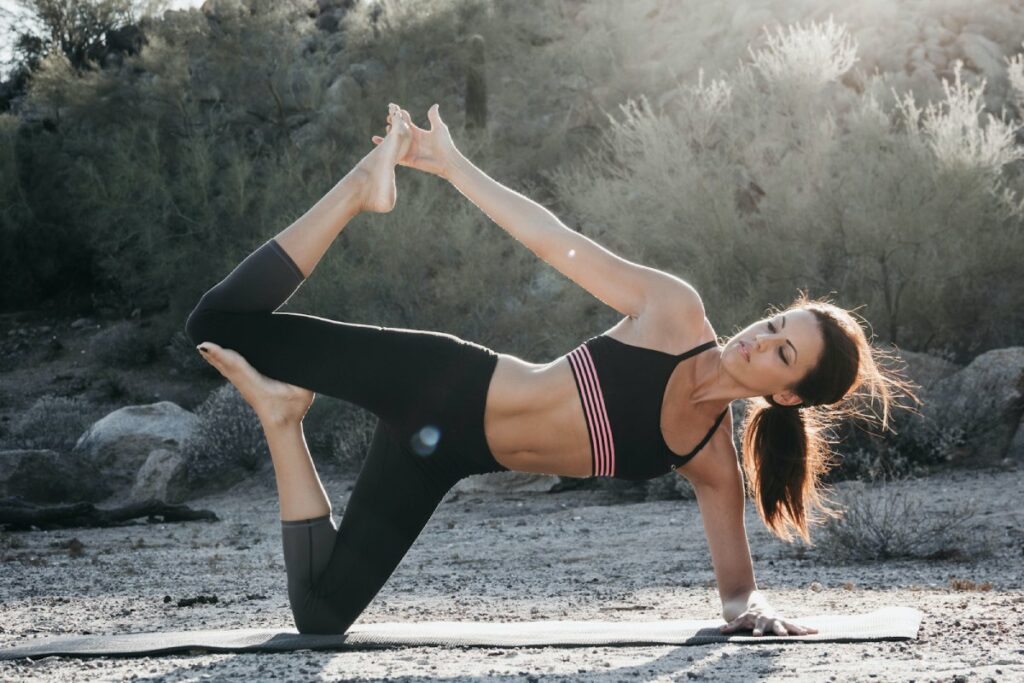Do you’ve gotten delicate knees or discover the kneeling place uncomfortable?
If that’s the case, you most likely dread doing yoga poses like cat-cow, camel, or low lunge.
The kneeling place can stress the knee joint considerably, and these asanas really feel uncomfortable and painful for a lot of yogis.
Nonetheless, if so for you, you don’t should skip each yoga kneeling pose. As an alternative, you can also make this place safer and extra comfy in a number of methods, which we are going to cowl on this article.
And you should definitely learn till the tip as we’ll cowl the ten commonest kneeling yoga poses in yoga and tips on how to do them.
Let’s dive in!
How To Defend Your Knees In Kneeling Yoga Poses

Kneeling poses, just like the Hero pose, contain a excessive diploma of knee flexion, and asanas like Camel require you to place your complete physique weight on these delicate joints. So it’s no shock that knee accidents are among the many commonest yoga accidents.
The important thing to caring for your knee joints throughout kneeling yoga poses is to make use of further padding. Listed below are 3 ways you are able to do this:
Use a thick mat

When you really feel slight discomfort in kneeling yoga poses, switching to a thicker mat could also be sufficient. Yoga mat thickness can vary from 1mm to 10mm, so in case you are utilizing one that’s simply a few mm thick, this could possibly be what’s inflicting the painful sensation.
Now, it’s additionally price noting that when yoga mats are too thick, it reduces stability and steadiness in standing poses. Thus, 6mm thickness is a perfect steadiness; it’s thick sufficient to guard the knees however skinny sufficient to maintain you sturdy and centered in steadiness poses.
I exploit the 6mm lululemon Exercise Mat, which has a singular design the place the middle of the mat (the place your knees often are) is easy, whereas the highest and backside have a raised grippy textural floor to extend traction and stability. Plus, because it’s double-sided, the opposite aspect has a easy texture.
Use a folded blanket

For extra-sensitive knees, a thicker mat is probably not sufficient help. So I like to recommend getting a dense yoga blanket which you can fold up and place beneath your knees everytime you come right into a kneeling yoga pose.
Restorative yoga blankets are excellent as they’re heavy, thick, gentle, and comfy. I just like the Manduka Yoga Wool Blanket, produced from 100% sustainable supplies (75% Recycled wool and 25% Recycled artificial fibers). It’s exceptionally prime quality and long-lasting because of the overlocked edge stitching that forestalls fraying and the dense weaving that retains it in form after a number of washes.
Use yoga knee pads

An alternative choice to a blanket is yoga knee pads, a product designed to forestall ache and discomfort in yoga apply.
The lululemon Stackable Foam Yoga Pads are small cushioned pads that you just place beneath your knees in any kneeling pose for fast help and luxury. As they’re stackable, you need to use one, two, or three per knee, relying in your wants. In addition they have a suctioning design, in order that they keep firmly in place in your mat.
Extra tip – Respect your physique’s limitations
Together with utilizing prop help, being conscious and respectful of what your physique can and can’t do is crucial for stopping knee accidents in yoga.
For instance, some poses require excessive knee flexion, however that is inaccessible for folks with low mobility within the knee joint. When you attempt to bend your knee greater than it might probably, you threat twisting the joint out of alignment.
So slightly than pushing and pulling your physique, cut back the diploma of flexion. For instance, within the Hero pose, sit on one or two blocks to raise the hips and decrease the bend within the knee.
As well as, transfer out and in of kneeling yoga poses slowly and punctiliously to keep away from by accident bending the knee an excessive amount of too shortly. And in a low lunge pose the place the entrance knee is bent, watch out to not bend the knee an excessive amount of in order that it goes previous your toes. This is likely one of the commonest causes of knee accidents.
10 Kneeling Yoga Poses And How To Do Them
Kneeling yoga poses are sometimes practiced within the warm-up a part of a yoga sequence, serving to the physique put together for the standing postures. Nonetheless, they will also be sprinkled all through the apply as resting poses or cool-down postures on the finish.
Let’s discover the most typical kneeling poses in Hatha and Vinyasa yoga.
Hero Pose

Within the Hero pose place, you sit in your heels together with your toes collectively and knees absolutely flexed. This stretches and strengthens the knees, thighs, and ankles and has many therapeutic results, like reducing hypertension.
If you’re one of many many yogis that discover this diploma of knee flexion uncomfortable, place a pillow or bolster between your sitting bones and heels.
Thunderbolt Pose

Thunderbolt pose (Vajrasana) is just like Hero’s and infrequently assumed to be the identical posture. Nonetheless, the distinction in Thunderbolt is that the toes will not be collectively; thus, you sit in between your heels slightly than on them. This, in fact, will increase the knee flexion (and the chance for discomfort) even additional.
To switch this asana, sit on a block or pillow slightly than attempting to carry the sit bones to the ground. Stack as many props as wanted beneath your hips to discover a comfy place. For a deeper variation, you may attempt Supta Vajrasana, the place you lean again onto your forearms.
Baby Pose

The frequent resting asana, Baby pose, entails deep knee flexion, spinal flexion, and hip opening. You are able to do this posture with the knees collectively (which compresses the belly organs and stimulates digestion) or with the knees aside (for a deeper hip stretch).
When coming into the Baby pose, begin sitting in your heels in a Hero pose. Then, tilt ahead out of your hips to decrease your torso on or between your thighs. Hold your hips urgent all the way down to your heels as you come into the pose, and loosen up your brow to the bottom.
Cow Pose

Cow pose is a mild backbend practiced in a tabletop place on the arms and knees. For any pose in a tabletop place, guarantee your knees are instantly beneath your hips, and your wrists are beneath your shoulders. From this place, tilt your pelvis to arch your again and open the chest, gazing forwards.
Cat Pose

Cat pose virtually at all times comes after cow pose, with cat and cow practiced collectively in a collection of rounds. Whereas the cow pose extends the backbone and stretches the entrance physique, the cat pose flexes it and stretches the again. From cow pose, tuck your tailbone to spherical your again and tuck the chin to your chest.
Balancing Desk Pose

Balancing desk pose is one other asana practiced from the tabletop place. Nonetheless, this specific pose works on partaking and strengthening the core muscle groups and bettering steadiness and stability within the physique.
This yoga pose entails balancing your weight on one knee and one hand, which will increase the load on that exact knee. Thus, I like to recommend utilizing props to maintain your knees secure.
Lengthen your proper leg again and left arm ahead from all fours. Hold the floating arm and leg straight and have interaction the core as you maintain. Launch, then repeat on the opposite aspect, extending the left leg and proper arm.
Low Lunge Pose

The low lunge is one other yoga pose that requires you to place extra weight on one knee. It additionally entails bringing the opposite knee right into a flexed place, so care and warning is crucial when working towards the low lunge.
From a tabletop, step your proper foot between your arms with the knee instantly above the ankle. Untuck your again toes and have interaction your core as you straighten your backbone and lift your arms alongside your ears.
Half Splits Pose

The half-split pose is a beautiful hamstring stretch and a preparatory posture for the total splits.
From the low lunge, launch your arms to the bottom or two blocks on both aspect of the entrance foot. Press your hips again to straighten the entrance leg and fold your higher physique over the thigh. Calm down your head and neck and flex the toes in the direction of you to deepen the stretch behind the leg.
Gate Pose

The gate pose is a side-bending asana with one knee bent and the opposite leg prolonged to the aspect. It opens the aspect physique and stretches the muscle groups between the ribs, within the again, and hips whereas strengthening the ankles and toes.
Lengthen your proper leg out to the aspect from a kneeling place with the hips lifted. Make sure the toes face ahead (in the identical path because the hips), urgent the only real firmly into the bottom.
Convey your proper hand to the suitable thigh. As you inhale, attain your left arm up and over, stretching to the suitable aspect (the aspect of the prolonged leg). Look as much as your prime arm and breathe into the ribs.
Camel Pose

The camel pose is a deep backbend that stretches the chest, torso, neck, and quads whereas strengthening the again muscle groups, thighs, and knees.
Convey your arms to your decrease again from a kneeling place with the hips lifted. Slowly lean again as you press the hips forwards, creating an arch within the backbone. Subsequent, pull your elbows in the direction of one another behind you as you breathe into the chest. A extra superior variation is to carry the arms to the heels.
Ultimate Ideas on Yoga Kneeling Pose
Kneeling yoga poses aren’t simply painful for yogis with earlier knee accidents. It’s frequent for many individuals to have delicate or bony knees, making it considerably uncomfortable to position their physique weight over one or each knees.
Nonetheless, the answer to this downside is fairly easy. Switching to a thicker yoga mat or utilizing a blanket or knee pads could make kneeling poses safer, extra satisfying, and, thus, extra helpful.

